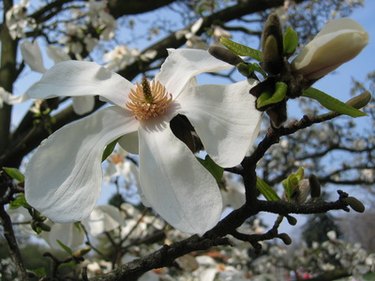
Flowering trees make attractive additions to any residential landscape or public space. While you can find flowering trees in most climates, certain species thrive better in particular conditions. The Northeast of the United States is marked by cold, snowy winters and mild, often humid summers. These conditions are ideal for many flowering tree types, many of which are introduced species.
Magnolia
Video of the Day
Found throughout the Northeast, magnolias are beautiful flowering trees that produce 3-to 4-inch-wide pinkish, white blossoms each spring. These trees grow best in acidic, well-drained, moist soil with either full sun or partial sun exposure. Magnolias can grow up to 30 feet and have an average spread of between 15 and 30 feet wide. They are relatively slow-growing trees that can take up to 20 years to bloom from the time you plant them. Fine Gardening recommends pruning these trees in late summer and late winter to avoid sap bleeding and ensure a healthy framework. Typical problems experienced by magnolia trees include weevils, bacterial leaf spot, scale insects, fungal spots and butt rot.
Video of the Day
Pagoda Dogwood
Named for its horizontal branches that resemble a pagoda structure, this tree produces creamy-colored, yellowish white blossoms that give off a sweet aroma. The pagoda dogwood also produces berries that feed a variety of Northeastern bird species and other animals. This tree will grow up to 25 feet and survives best in cultivation zones 4 through 8. Though the pagoda dogwood will survive in partial sunlight, it thrives and produces the most blossoms with direct sunlight. The tree prefers well-drained, slightly acidic soil. Other common names for the pagoda dogwood include pigeonberry and alternate-leaf dogwood.
Pin Cherry
This small deciduous tree (just 30 inches tall) grows throughout the Northeastern United States, particularly in Pennsylvania and New Jersey. Native Americans in the region used the pin cherry's bark for making baskets and ate its sour fruit raw or as a jam. Other names for the tree include northern pin cherry, wild red cherry, fire cherry and pigeon cherry. The pin cherry produces small white flowers that appear in clusters of five to seven blossoms. This tree survives best with soil that has a pH level of between 6.1 and 7.5. The tree also does well in moist, open forests and clearings. Its berries are popular food for birds.